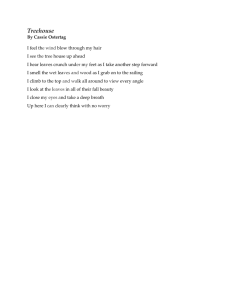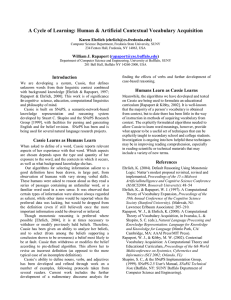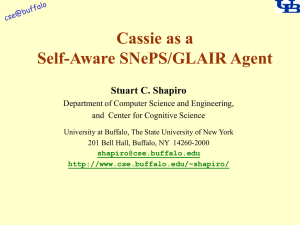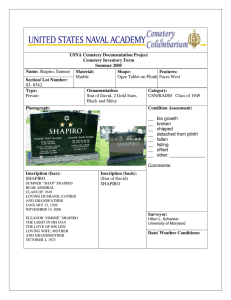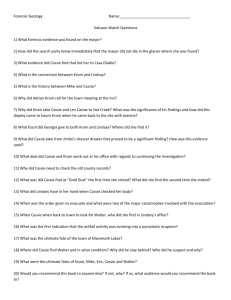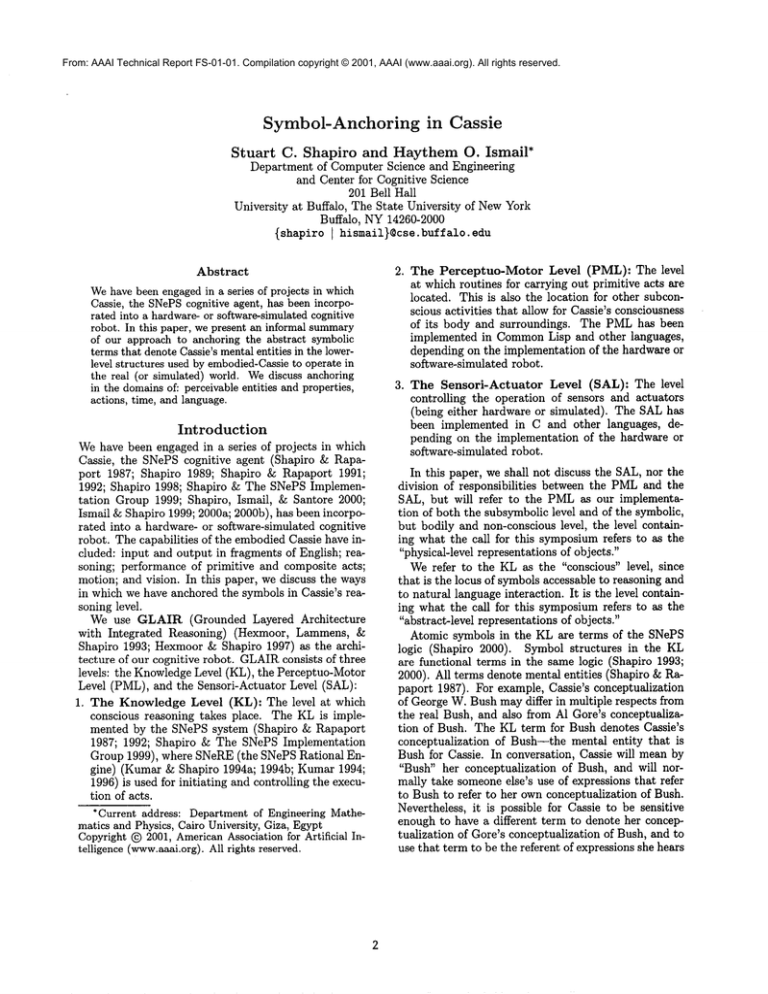
From: AAAI Technical Report FS-01-01. Compilation copyright © 2001, AAAI (www.aaai.org). All rights reserved.
Symbol-Anchoring
in Cassie
Stuart
C. Shapiro
and Haythem O. Ismail*
Department of Computer Science and Engineering
and Center for Cognitive Science
201 Bell Hall
University at Buffalo, The State University of NewYork
Buffalo, NY14260-2000
{shapiroI hismail}@cse.buffalo.edu
Abstract
Wehave been engagedin a series of projects in which
Cassie, the SNePScognitive agent, has been incorporated into a hardware-or software-simulatedcognitive
robot. In this paper, we present an informal summary
of our approach to anchoring the abstract symbolic
terms that denote Cassie’smentalentities in the lowerlevel structures used by embodied-Cassie
to operate in
the real (or simulated) world. Wediscuss anchoring
in the domainsof: perceivableentities and properties,
actions, time, and language.
Introduction
Wehave been engaged in a series of projects in which
Cassie, the SNePScognitive agent (Shapiro & Rapaport 1987; Shapiro 1989; Shapiro & Rapaport 1991;
1992; Shapiro 1998; Shapiro & The SNePSImplementation Group 1999; Shapiro, Ismail, & Santore 2000;
Ismail &Shapiro 1999; 2000a; 2000b), has been incorporated into a hardware- or software-simulated cognitive
robot. The capabilities of the embodiedCassie have included: input and output in fragments of English; reasoning; performance of primitive and composite acts;
motion; and vision. In this paper, we discuss the ways
in which we have anchored the symbols in Cassie’s reasoning level.
We use GLAIR(Grounded Layered Architecture
with Integrated Reasoning) (Hexmoor, Lammens,
Shapiro 1993; Hexmoor& Shapiro 1997) as the architecture of our cognitive robot. GLAIR
consists of three
levels: the KnowledgeLevel (KL), the Perceptuo-Motor
Level (PML), and the Sensori-Actuator Level (SAL):
1. The Knowledge Level (KL): The level at which
conscious reasoning takes place. The KLis implemented by the SNePSsystem (Shapiro & Rapaport
1987; 1992; Shapiro & The SNePS Implementation
Group 1999), where SNeRE(the SNePSRational Engine) (Kumar & Shapiro 1994a; 1994b; Kumar1994;
1996) is used for initiating and controlling the execution of acts.
*Current address: Departmentof Engineering Mathematics and Physics, Cairo University, Giza, Egypt
Copyright(~) 2001, AmericanAssociationfor Artificial Intelligence (www.aaai.org).
All rights reserved.
2. The Perceptuo-Motor Level (PML): The level
at whichroutines for carrying out primitive acts are
located. This is also the location for other subconscious activities that allow for Cassie’s consciousness
of its body and surroundings. The PMLhas been
implemented in Common
Lisp and other languages,
depending on the implementation of the hardware or
software-simulated robot.
3. The Sensori-Actuator
Level (SAL): The level
controlling the operation of sensors and actuators
(being either hardware or simulated). The SALhas
been implemented in C and other languages, depending on the implementation of the hardware or
software-simulated robot.
In this paper, we shall not discuss the SAL,nor the
division of responsibilities between the PMLand the
SAL, but will refer to the PMLas our implementation of both the subsymboliclevel and of the symbolic,
but bodily and non-conscious level, the level containing what the call for this symposiumrefers to as the
"physical-level representations of objects."
Werefer to the KLas the "conscious" level, since
that is the locus of symbolsaccessable to reasoning and
to natural languageinteraction. It is the level containing what the call for this symposiumrefers to as the
"abstract-level representations of objects."
Atomic symbols in the KL are terms of the SNePS
logic (Shapiro 2000). Symbol structures in the
are functional terms in the same logic (Shapiro 1993;
2000). All terms denote mental entities (Shapiro & Rapaport 1987). For example, Cassie’s conceptualization
of GeorgeW. Bush maydiffer in multiple respects from
the real Bush, and also from A1 Gore’s conceptualization of Bush. The KLterm for Bush denotes Cassie’s
conceptualization of Bush--the mental entity that is
Bush for Cassie. In conversation, Cassie will mean by
"Bush" her conceptualization of Bush, and will normally take someoneelse’s use of expressions that refer
to Bush to refer to her ownconceptualization of Bush.
Nevertheless, it is possible for Cassie to be sensitive
enough to have a different term to denote her conceptualization of Gore’s conceptualization of Bush, and to
use that term to be the referent of expressions she hears
Gore use.
Since KLterms denote mental entities, there is a
1-1 correspondence between KL terms and those mental entities Cassie has so far conceived of. For example,
if Cassie believed that the MorningStar is the Evening
Star, she would have one KLterm to denote the Morning Star, another KLterm to denote the Evening Star,
and a third KLterm to denote the proposition that the
two have the same extension. WhenCassie conceives of
a mental entity she does not recognize (re-cognize)
one for which she already has a KLterm, she creates a
new KL term to denote it (Maida & Shapiro 1982).
The topic of this paper is our approach to anchoring
the KLterms that denote Cassie’s mental entities in
the PMLstructures used by embodied-Cassie to operate in the real world. Briefly, our theoretical stance is
that KLterms are accessible to natural language interaction and to reasoning--Cassie can discuss and reason
about the entities they denote. PMLstructures, on
the other hand, are accessable to sensors and effectors,
but not to natural language interaction or reasoning.
Anchoringis achieved by associating (we use the term
"aligning") a KLterm with a PMLstructure, thereby
allowing Cassie to recognize entities and perform actions, but not to discuss or reason about the low-level
recognition or performance. In the following sections,
we discuss anchoring in the domainsof: perceivable entities and properties, actions, time, and language. This
paper has deliberately been kept as an informal summary of our approach. For more details, and more formal presentations, see the papers cited herein.
Perceivable
Entities
There are KLterms for every mental entity Cassie has
conceivedof, including individual entities, categories of
entities, colors, shapes, and other properties of entities.
Weassume there are PMLstructures for features of
the perceivable world that Cassie’s perceptual apparatus can detect and distinguish. For example, each
distinguishable color might be represented by a single
number, by a symbol, or by a triple of RGBvalues, and
each distinguishable shape might be represented by a
single number or symbol. Wefurther assume that each
particular perceived object will be represented at this
level by a collection of such structures. Withoutloss of
generality (we believe), we will assumethat these collections of PMLstructures can be considered to be feature
vectors. (Wehave used feature vectors in versions of
embodied-Cassie we have implemented.) A feature vector is a sequenceof values, (vl,..., v~), whereeach vi
a possible value of somedimension Di. A feature vector
can also be interpreted as a point in an n-dimensional
feature space, where the i th dimension is Di. Whatdimensions are used depends on the perceptual apparatus
of the robot.
Our approach to grounding KL terms for perceivable entities, categories, and properties is to align a KL
term with a PMLfeature vector, possibly with unfilled
(null) components. For example, one version of embodied Cassie used a two-dimensional feature vector in
which the dimensions were color and shape. The KL
term denoting Cassie’s idea of blue was aligned with
a feature vector whose color component was the PML
structure the vision system used whenit detected blue
in the visual field, but whoseshape componentwas null.
The KLterm denoting cubes was aligned with a feature
vector whose shape component was the PMLstructure
the vision system used when it detected a cube in the
visual field, but whose color componentwas null. We
have implementedalignment in various ways, including
association lists, hash tables, and property lists.
Let us call a feature vector with some null components an "incomplete feature vector", and one with no
null componentsa "complete feature vector".
KLterms denoting perceivable properties and KL
terms denoting recognizable categories of entities are
typically aligned with incomplete feature vectors. Examples include the terms for blue and for cubes mentioned above, and mayalso include terms for tall, fat,
bearded, man, and woman. These terms may be combined into verbal descriptions, such as "a tall, fat,
bearded man," that may be used to perceptually recognize the entity so described. In this paper, we will not
use the term "description" to meana verbal description
that cannot be used for perceptual recognition, such as
%college-educated businessman wholives in Amherst,
NY."
Cassie might have a KL term for an entity about
which she knows no descriptive terms. For example,
all she might believe about Fred is that he is a collegeeducated businessman who lives in Amherst, NY.Thus,
she would be incapable of describing Fred (the way we
are using "describe"). Nevertheless, it might be the
case that Cassie’s term denoting Fred is aligned with
a complete feature vector. In this case, Cassie would
be able to recognize Fred, though not describe him.
Wecall such a complete feature vector aligned with an
entity, the entity’s "PML-description." To emphasize
its completeness, we can use the term "complete PMLdescription."
A complete PML-description may be assembled for
an entity by unifying the incomplete PML-descriptions
of its known(conceived of) properties and categories.
For example, if Cassie knowsnothing about Harry, and
we tell her that Harry is a tall, fat, bearded man,
she would be able to assemble a PML-description of
Harry and recognize him on the street. (Assuming
that Cassie’s terms for tall, fat, bearded, and manare
aligned with incompletefeature vectors.) In somecases,
this might result in a set of several complete PML°
descriptions. For example, the PML-descriptions of
some, but not a particular, red chair might include feature vectors with different shape components. Once a
PML-descriptionis assembled for an entity, it can be
cached by aligning the entity directly with it. Afterwards, Cassie could recognize the entity without thinking about what it looks like.
To find (cometo be looking at) an entity, Cassie finds
a PML-descriptionof the entity that is as complete as
possible, and directs her perceptual apparatus to do
what is necessary to cause an object satisfying that
feature vector to be in her visual field. (See the section on actions, below, for a description of howactions
are grounded.)
If Cassie is looking at someobject, she can recognize
it if its feature vector is the PML-descriptionof some
entity she has already conceived of. If there is no such
entity, Cassie can create a new KLterm to denote this
newentity, and believe of it that it has those properties
and is a memberof those categories whosepartial PMLdescriptions are parts of the PML-description of the
newentity.
If there are multiple entities whosePML-descriptions
match the feature vector, disambiguation is needed, or
Cassie might simply not knowwhich one of the entities
she is looking at.
Weare currently investigating the issue of when
Cassie might decide that the object she is looking at
is new, even though it looks exactly like another she
has already conceived of.
Wehave not worked on the problem of recognizing
an entity by context. For example a store clerk might
be recognized as any person standing behind a cash
register3 Wespeculate that this problem requires a
combination of KL knowledge and KL-PML
alignment.
Knowingthat a person standing behind a cash register
is a clerk is KL knowledge. Recognizing a person, a
cash register, and the "behind" relation requires KLPMLalignment.
Example
This subsection contains an example interaction
with a simulated version of Cassie as a "Foveal
Extra-Vehicular Activity Helper-Retriever (FEVAHR)"
(Shapiro 1998). Cassie, the FEVAHR,was implemented on a commercial Nomadrobot, including sonar,
bumpers, and wheels, enhanced with a foveal vision
system consisting of a pair of cameras with associated
hardware and software. The simulated version allows
interactions to be shownin a paper.
In this simulation, both the PMLand the simulated
world are implemented in CommonLisp. The PML
feature vector has two dimensions, called "color" and
"shape". There are seven objects in the simulated
world. The Common
Lisp symbols that represent these
objects and their PML-descriptions are shown in the
following table:
1This examplewas suggested by one of the anonymous
reviewers.
4
Object
Color
WORLD: BILL
BLUE
WORLD: STU
YELLOW
WORLD: CASSIE CYAN
WORLD: GREENIE GREEN
WORLD: REDROB-IRED
WORLD: REDROB-2RED
WORLD: REDROB-3RED
Shape
SQUARE
SQUARE
CIRCLE
CIRCLE
CIRCLE
CIRCLE
CIRCLE
The KLterms that are aligned with feature vectors
are shownin the following table:
KL Term
B1
B5
B6
green
red
person
robot
Color
CYAN
YELLOW
BLUE
GREEN
RED
NIL
NIL
Shape
CIRCLE
SQUARE
SQUARE
NIL
NIL
SQUARE
CIRCLE
Notice that B1, B5, and B6 are aligned with complete
feature vectors, while green, red, person, and robot
are aligned with incompletefeature vectors. B1, B5, and
B6 denote individuals, green and red denote properties. person and robot denote categories.
Cassie’s relevant beliefs about the entities denotedby
these terms maybe glossed as:
B1 ’s name
nameisis Stu.
Cassie.
BS’s
B6’s nameis Bill.
Cassie is a FEVAHR.
FEVAHRsare robots.
Bill and Stu are people.
Robbieis a green robot.
BS, Bg, and BIOare red robots.
Peopleand robots are things.
The only descriptive terms Cassie has for Bill and Stu
are that they are people, and the only descriptive term
she has for herself is that she is a robot. Nevertheless, Bill, Stu, and Cassie are aligned with complete
feature vectors, so she has PML-descriptionsfor them,
and, therefore, can recognize them. On the other hand,
Robbie, B8, B9, and B10 are not aligned with any feature vectors, but PML-descriptions can be assembled
for them from their properties and categories.
Following is an interaction with Cassie about these
entities. Sentences preceded by ":" are humaninputs.
Sentences starting with "The FEVAHR
is" are reports
of simulated actions and perceptions, and are not output by the hardware version. Sentences beginning with
"r’ are generated by Cassie. At the beginning of the
interaction, Cassie is looking at listening to, and talking
to Stu.
: Finda robot.
The FEVAHRis lookingfor something
that’sa CIRCLE.
The FEVAHRfoundWORLD:REDROB-1.
I founda red robot.
The FEVAHRis lookingat WORLD:REDROB-I.
I am lookingat a red robot.
: Finda person.
The FEVAHRis lookingfor something
that’sa SQUARE.
The FEVAHRfoundWORLD:STU.
I foundyou, Stu.
The FEVAHRis lookingat WGRLD:STU.
I am lookingat you.
: Finda greenthing.
The FEVAHRis lookingfor something
that’sGREEN.
The FEVAHRfoundWORLD:GREENIE.
I foundRobbie.
The FEVAHRis lookingat WORLD:GREENIE.
I am lookingat Robbie.
: FindBill.
The FEVAHRis lookingfor something
that’sBLUEand a SQUARE.
The FEVAHRfoundWORLD:BILL.
I foundBill.
The FEVAHRis lookingat WORLD:BILL.
I am lookingat Bill.
Attentional
Structures
Cassie’s attentional apparatus is modeled by a set of
PMLregisters (variables), each of which can hold one
or more KL terms or PMLstructures. Some of these
registers derive from the theory of the Deictic Center
(Duchan, Bruder, & Hewitt 1995), and include: I, the
register that holds the KLterm denoting Cassie herself,
and NOW,the register that holds the KLterm denoting
the current time. Others, termed "modality registers",
modelCassie’s knowledgeof what she is doing. For example, if one of Cassie’s modalities were speech, and she
were currently talking to Stu, her SPEECH
register would
contain the KLterm denoting the state of Cassie’s talking to Stu. In manycases, a single modality of an agent
can be occupied by only one activity at a time. In that
case the modality register for that modality would be
constrained to contain only one term at a time.
One of the modality registers we have used is one
to keep track of what Cassie is looking at. Whenshe
recognizes an object in her visual field, the KLterm
denoting the state of looking at the recognized entity is
placed in the register, and is removedwhenthe object is
no longer in the visual field. If one assumesthat Cassie
can be looking at several objects at once, this register
wouldbe allowed to contain several terms.
If askedto look at or find somethingthat is already in
her visual field, Cassie recognizesthat fact, and doesn’t
need to do anything. The followinginteraction continues from the previous one:
: Lookat Robbie.
The FEVAHRis lookingfor something
that’sGREENand a CIRCLE.
The FEVAHRfoundWORLD:GREENIE.
I foundRobbie.
The FEVAHRis lookingat WORLD:GREENIE.
I am lookingat Robbie.
: Finda robot.
I am lookingat Robbie.
Comparing
Cassie’s
response
to thesecondrequest
withherresponse
to theprevious
requests,
onecan
seethatsherealized
thatshewasalready
looking
at
a robot,
andso didn’t
needto doanything
to findone.
Actions
SomeKLterms denote primitive actions that Cassie can
perform. Weterm an action, along with the entity or
entities it is performedon, to be an "act". For example,
the act of going to Bill consists of the action of going
and the object Bill. Acts are denoted by KLfunctional
terms.
Each KLaction term that denotes a primitive action
that Cassie can perform is aligned with a procedure in
the PML. The procedure takes as arguments the KL
terms for the argumentsof the act Cassie is to perform.
For example, if Cassie is to perform the act of going to
Bill, the PMLgoing-procedure would be called on the
KLBill-term. It would then find the PML-description
of Bill, and cause the robot hardware to go to an object in the worldthat satisfies that description (or cause
the robot simulation to simulate that behavior). The
PMLgoing-procedure would also insert the KL term
denoting the state of Cassie’s going to Bill into the relevant modality register(s), which, whenNOW
moves(see
below), would cause an appropriate proposition to be
inserted into Cassie’s belief space.
Acts whoseactions are primitive are considered to be
primitive acts. Composite acts are composedof primitive "control actions", and their arguments, which,
themselves are primitive or composite acts. Control
actions include sequence, selection, iteration, and nondeterministic choice (Kumar& Shapiro 1994a; 1994b;
Kumar 1994; 1996; Shapiro & The SNePS Implementation Group 1999; Ismail & Shapiro 1999). There are
also propositions for act preconditions, goals, effects,
and for plans (what somecall recipes) for carrying out
non-primitive acts.
In the interactions shownabove, sentences starting
with "The FEVAHR
is" were printed by the simulated
action function which was called by the PMLprocedure aligned with the KLterm for finding something.
WhenCassie was asked to look at Robbie, she did so
by finding Robbie, because there is a KLbelief that the
plan for carrying out the non-primitive act of looking
at somethingis to find that thing.
Time
As mentioned above, the attentions] NOW
register always contains the KL term denoting the current time
(Shapiro 1998; Ismail & Shapiro 2000b; 2001). Actually, since "now" is vague (it could meanthis minute,
this day, this year, this century, etc.), N0W
is considered
to include the entire semi-lattice of times that include
the smallest current now-interval Cassie has conceived
of, as well as all other times containing that interval.
N0Wmoves whenever Cassie becomes aware of a new
state. Someof the circumstances that cause her to becomeaware of a new state are: she acts; she observes a
state holding; she is informed of a state that holds. N0W
movesby Cassie’s conceiving of a new smallest current
now-interval (a new KLterm is introduced with that
denotation), and N0Wis changed to contain that time.
The other times in the old N0Ware defeasibly extended
into the new one by adding propositions asserting that
the new N0W
is a subinterval of them.
WheneverCassie acts, the modality registers change
(see above), and N0Wmoves. The times of the state(s)
newly added to the modality registers are included in
the new N0Wsemi-lattice, and the times of the state(s)
deleted from the modality registers are placed into the
past by adding propositions that assert that they precede the new NOW.
The following interaction, following the ones shown
above, shows an action of Cassie’s passing from the
present into the past:
: Who have you talkedto?
I am talkingto you.
: Talkto Bill.
The FEVAHRis starZingto talk to Bill.
I am talkingto you,Bill.
: Who have you talkedto?
I talkedto Stu
and I am talkingto you.
Temporal Durations
To give Cassie a "feel" for the amountof time that has
passed, she has a COUNT
register acting as an internal
pacemaker. The value of COUNT
is a non-negative integer, incremented at regular intervals. WheneverNOW
moves, the following happens:
1. the old now-interval to is aligned with the current
value of COUNT,
grounding it in a PML-measure
of its
duration;
2. the value of COUNT
is quantized into a value 5 which
is the nearest half-order of magnitude (Hobbs 2000)
to COUNT,providing an equivalence class of PMLmeasuresthat are not noticeably different;
3. a KL term d, aligned with 5, is found or created,
providing a mental entity denoting each class of durations;
4. a belief is introduced into the KLthat the duration
of to is d, so that Cassie can have beliefs that two
different states occurred for about the samelength of
time;
is reset to 0, to prepare for measuringthe new
5. COUNT
now-interval.
Language
Cassie interacts with humansin a fragment of English.
Althoughit is possible to represent all her linguistic
knowledgein the KL, use reasoning to analyze input
utterances (Shapiro &Neal 1982; Neal & Shapiro 1985;
1987a; 1987b), and use the acting system to generate utterances (Hailer 1996; 1999), we do not currently do this. Instead, the parsing and generation
grammars, as well as the lexicon, are at the PML.
(See, e.g. (Shapiro 1982; Shapiro & Rapaport 1995;
Rapaport, Shapiro, & Wiebe 1997).) There are
terms for lexemes, and these are aligned with lexemes
in the PMLlexicon. Wemost frequently use a KLunary
functional term to denote the concept expressed by a
given lexeme, but this does not allow for polysemy, so
we have occasionally used binary propositions that assert that someconcept maybe expressed by some lexeme.
This facility was used for Cassie to understand the
humaninputs shownin the exampleinteractions in this
paper, and for her to generate her responses (the sentences beginning with "I"). Wecan also use the low
level surface function to see the NLexpression Cassie
would use to express the denotation of various SNePS
2:
terms
* (surface
Cassie
B1)
* (surface
Stu
B5)
* (surface
you
B6)
(Remember,Cassie is currently talking to Bill.)
Summary
Wehave given an informal summaryof our approach
to connecting the abstract-level representations to the
physical-level representations of Cassie, our cognitive
robot. The abstract-level representations are terms of
SNePSlogic contained in the KnowledgeLevel (KL)
our GLAIRagent architecture, while the physical-level
representations are feature vectors, procedures, and
other symbol structures contained at the PerceptuoMotor Level (PML)of the architecture.
KLterms denoting perceivable entities, perceivable
properties, and recognizable categories are aligned with
PMLfeature vectors. Primitive actions are aligned with
2Thepromptfor this Lispish interaction level is "*".
PMLprocedures. Deictic and modality registers hold
KLterms for individuals and states that Cassie is currently aware of, including states of her ownbody. They
are updated by the PMLprocedures. The NOW
register
is used to give Cassie a personal sense of time, including keeping track of current and past states. KLterms
denoting times and temporal durations are aligned with
PMLnumeric measures of durations created by the
PMLpacemaker. Lexemes are represented by KL terms
that are aligned with PMLlexicon entries used by the
parsing and generation grammars, which, like PMLprocedures, mediate between Cassie and the outside world,
in this case, humanswith which she communicates.
Acknowledgments
SNePSand Cassie are products of SNeRG,the SNePS
Research Group, Department of Computer Science and
Engineering, University at Buffalo. Manygroup members, past and present, have contributed to these efforts. Weappreciate the valuable commentson previous
drafts of this paper made by William J. Rapaport and
other current members of SNeRG,and by two anonymous reviewers.
References
Brachman,R. J., and Levesque,H. J., eds. 1985. Readings in Knowledge Representation. San Mateo, CA:
Morgan Kaufmann.
Duchan, J. F.; Bruder, G. A.; and Hewitt, L. E., eds.
1995. Deixis in Narrative: A Cognitive Science Perspective. Hillsdale, N J: LawrenceErlbaumAssociates,
Inc.
Hailer, S. 1996. Planning text about plans interactively. International Journal of Expert Systems
9(1):85-112.
Haller, S. 1999. An introduction to interactive discourse processing from the perspective of plan recognition and text planning. Artificial Intelligence Review
13(4):259-333.
Hexmoor, H., and Shapiro, S. C. 1997. Integrating
skill and knowledgein expert agents. In Feltovich,
P. J.; Ford, K. M.; and Hoffman,R. R., eds., Expertise
in Context. Cambridge, MA:AAAIPress/MIT Press.
383-404.
Hexmoor,H.; Lammens,J.; and Shapiro, S. C. 1993.
Embodimentin GLAIR:a grounded layered architecture with integrated reasoning for autonomousagents.
In Dankel II, D. D., and Stewman, J., eds., Proceedings of The Sixth Florida AI Research Symposium
(FLAIRS93). The Florida AI Research Society. 325329.
Hobbs, J. R. 2000. Half orders of magnitude. In
Obrst, L., and Mani, I., eds., Papers from the Workshop on Semantic Approximation, Granularity, and
Vagueness, 28-38. A Workshopof the Seventh International Conference on Principles of KnowldegeRepresentation and Reasoning, Breckenridge, CO.
Ismail, H. O., and Shapiro, S. C. 1999. Cascaded
acts: Conscioussequential acting for embodiedagents.
Technical Report 99-10, Department of ComputerScience and Engineering, University at Buffalo, Buffalo,
NY.Submitted for journal publication.
Ismall, H. O., and Shapiro, S. C. 2000a. Conscious
error recovery and interrupt handling. In Arabnia,
H. R., ed., Proceedingsof the International Conference
on Artificial Intelligence (IC-AI’2000), 633-639. Las
Vegas, NV: CSREAPress.
Ismall, H. O., and Shapiro, S. C. 2000b. Twoproblems with reasoning and acting in time. In Cohn,
A. G.; Giunchiglia, F.; and Selman, B., eds., Principles of KnowledgeRepresentation and Reasoning:
Proceedings of the Seventh International Conference
(KR 2000), 355-365. San Francisco: Morgan Kaufmann.
Ismail, H. O., and Shapiro, S. C. 2001. The cognitive
clock: A formal investigation of the epistemology of
time. Technical Report 2001-08, Department of Computer Science and Engineering, University at Buffalo,
Buffalo, NY.Submitted for journal publication.
Kumar,D., and Shapiro, S. C. 1994a. Acting in service
of inference (and vice versa). In Dankel II, D. D.,
ed., Proceedings of The Seventh Florida AI Research
Symposium (FLAIRS 94). The Florida AI Research
Society. 207-211.
Kumar, D., and Shapiro, S. C. 1994b. The OKBDI
architecture. International Journal on Artificial Intelligence Tools 3(3):349-366.
Kumar, D. 1994. From Beliefs and goals to Intentions and Actions: An AmalgamatedModel of Inference and Acting. Ph.d. dissertation, technical report
94-04, State University of NewYork at Buffalo, Buffalo, N’Y.
Kumar, D. 1996. The SNePSBDI architecture. Decision Support Systems 16(1):3-19.
Lehmann,F., ed. 1992. Semantic Networks in Artificial Intelligence. Oxford: PergamonPress.
Maida, A. S., and Shapiro, S. C. 1982. Intensional
concepts in propositional semantic networks. Cognitive Science 6(4):291-330. Reprinted in (Brachman
Levesque 1985, pp. 170-189).
Neal, J. G., and Shapiro, S. C. 1985. Parsing as a
form of inference in a multiprocessing environment. In
Proceedings of the Conference on Intelligent Systems
and Machines, 19-24. Rochester, Michigan: Oakland
University.
Neal, J. G., and Shapiro, S.C. 1987a. Knowledge representation for reasoning about language. In
Boudreaux, J. C.; Hamill, B. W.; and Jernigan, R.,
eds., The Role of Languagein Problem Solving 2. Elsevier Science Publishers. 27-46.
Neal, J. G., and Shapiro, S. C. 1987b. Knowledgebased parsing. In Bolc, L., ed., Natural Language
Parsing Systems. Berlin: Springer-Verlag. 49-92.
Robotics: Papers from the 1998 AAAI Fall Symposium, Technical Report FS-98-02. MenloPark, California: AAAIPress. 136-143.
Shapiro, S. C. 2000. SNePS:A logic for natural language understanding and commonsensereasoning. In
Iwafiska, L., and Shapiro, S. C., eds., Natural Language Processing and KnowledgeRepresentation: Language for Knowledge and Knowledge for Language.
Menlo Park, CA: AAAIPress/The MIT Press. 175195.
Orilia, F., and Rapaport, W. J., eds. 1998. Thought,
Language, and Ontology: Essays in Memory of
Hector-Neri Casta~eda. Dordrecht: Kluwer Academic
Publishers.
Rapaport, W. J.; Shapiro, S. C.; and Wiebe, J. M.
1997. Quasi-indexicals and knowledge reports. Cognitive Science 21(1):63-107. Reprinted in (Orilia
Rapaport 1998, pp. 235-294).
Shapiro, S. C., and Neal, J. G. 1982. A knowledgeengineering approach to natural language understanding.
In Proceedings of the 20th Annual Meeting of the Association for ComputationalLinguistics. MenloPark,
CA: ACL. 136-144.
Shapiro, S. C., and Rapaport, W. J. 1987. SNePS
considered as a fully intensional propositional semantic network. In Cercone, N., and McCalla, G., eds.,
The KnowledgeFrontier. NewYork: Springer-Verlag.
263-315.
Shapiro, S. C., and Rapaport, W. J. 1991. Models and minds: Knowledgerepresentation for naturallanguage competence. In Cummins,R., and Pollock,
J., eds., Philosophy and AI: Essays at the Interface.
Cambridge, MA:MIT Press. 215-259.
Shapiro, S. C., and Rap aport, W. J. 1992. The SNePS
family. Computers 8~ ~lathematics with Applications
23(2-5):243-275. Reprinted in (Lehmann 1992,
243-275).
Shapiro, S. C., and Rapaport, W. J. 1995. An introduction to a computational reader of narratives. In
Duchan,J. F.; Bruder, G. A.; and Hewitt, L. E., eds.,
Deixis in Narrative: A Cognitive Science Perspective.
Hillsdale, N J: LawrenceErlbaumAssociates, Inc. 79105.
Shapiro, S. C., and The SNePS Implementation
Group. 1999. SNePS 2.5 User’s Manual. Department
of ComputerScience and Engineering, State University of NewYorkat Buffalo, Buffalo, N-Y.
Shapiro, S. C.; Ismail, H. O.; and Santore, J. F. 2000.
Our dinner with cassie. In Working Notes for the
AAAI 2000 Spring Symposium on Natural Dialogues
with Practical Robotic Devices, 57-61. Menlo Park,
CA: AAAI.
Shapiro, S. C. 1982. Generalized augmented transition network grammarsfor generation from semantic
networks. The American Journal of Computational
Linguistics 8(1):12-25.
Shapiro, S. C. 1989. The CASSIE projects:
An
approach to natural language competence. In Martins, J. P., and Morgado, E. M., eds., EPIA 89: 4th
Portugese Conference on Artificial Intelligence Proceedings, Lecture Notes in Artificial Intelligence 390.
Berlin: Springer-Verlag. 362-380.
Shapiro, S. C. 1993. Belief spaces as sets of propositions. Journal of Experimentaland Theoretical Artificial Intelligence (YETAI) 5(2&3):225-235.
Shapiro, S. C. 1998. EmbodiedCassie. In Cognitive
8


